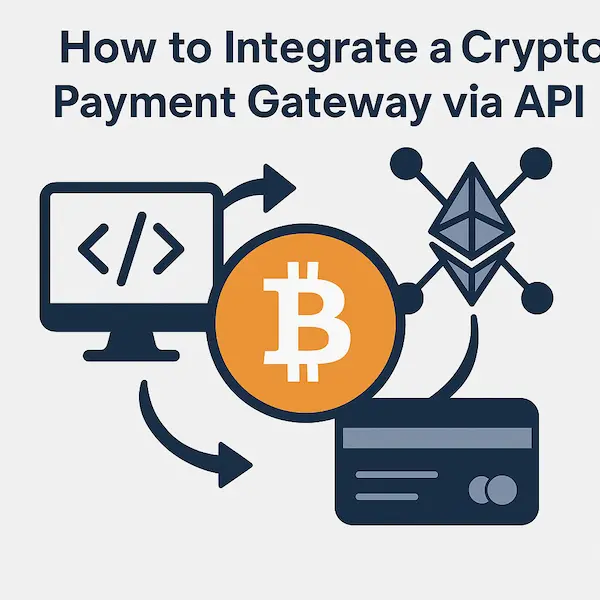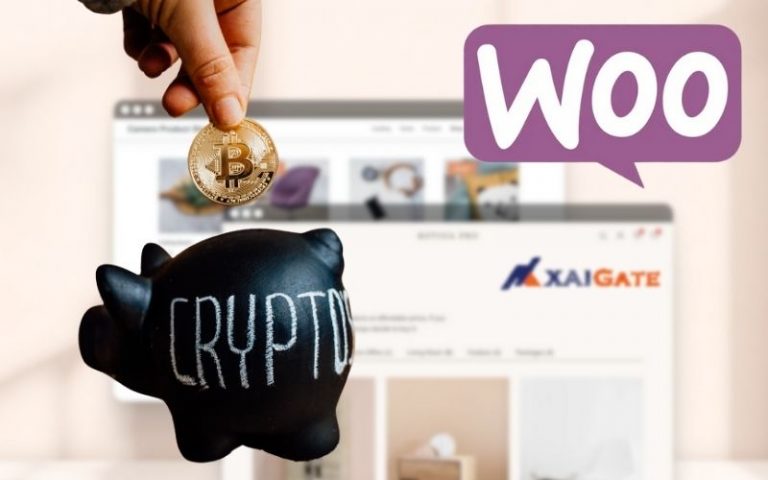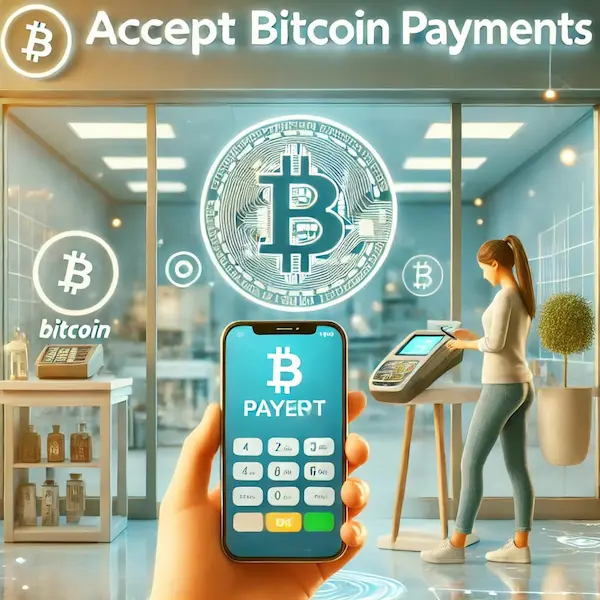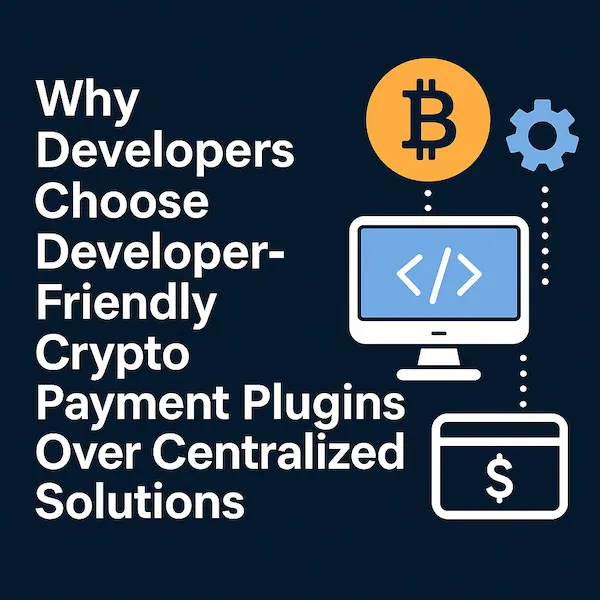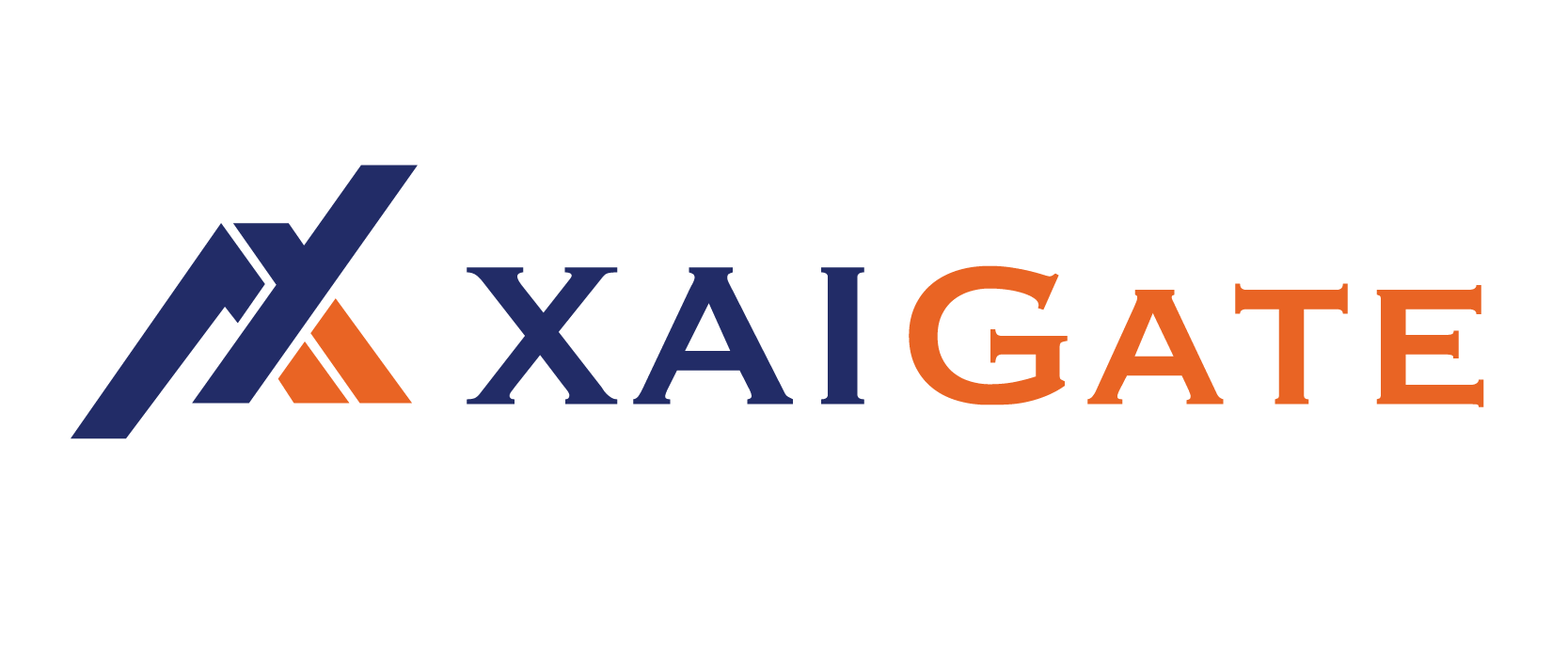Digital payment world is quickly changing and cryptocurrency or cryptocurrency has become a payment game changer. With a growing number of businesses and organizations accepting crypto payments as their mode of payment, developers should know how to implement a crypto payment gateway that can fit perfectly into their programs. This all-inclusive guide will take you through all you need to know about using crypto payment solutions through API.
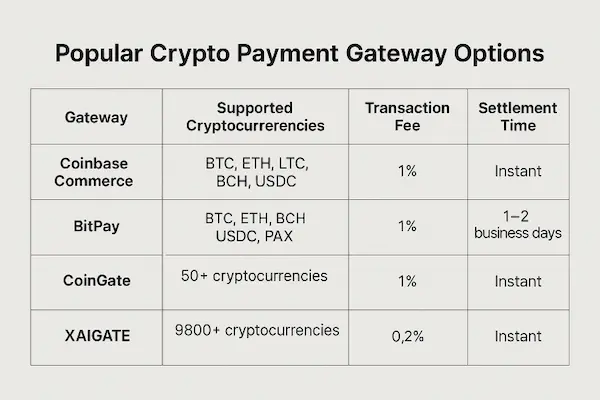
Contents
- 1 Understanding Crypto Payment Gateways
- 2 Popular Crypto Payment Gateway Options
- 3 Pre-Integration Requirements
- 4 Step-by-Step Integration Process
- 5 API Integration Best Practices
- 6 Security Considerations
- 7 Testing Your Integration
- 8 Common Integration Challenges and Solutions
- 9 Performance Optimization
- 10 Monitoring and Analytics
- 11 Conclusion
- 12 Frequently Asked Questions
Understanding Crypto Payment Gateways
What is a crypto payment gateway? A crypto payment gateway is the interface between your application and blockchain network. It manages the complicated procedure of cryptocurrency exchange, turning digital currencies into standard currency when necessary. By incorporating a crypto payment gateway, you will basically have a complex payment processing system that supports crypto payments in the form of Bitcoin, Ethereum, and other major cryptos.
Why Choose Crypto Payment Integration?
The benefits of crypto payment integration extend far beyond just accepting digital currencies. Here are the key advantages:
- Lower transaction fees compared to traditional payment processors
- Global accessibility without geographic restrictions
- Faster settlement times, especially for international transactions
- Enhanced security through blockchain technology
- Reduced chargeback risks due to irreversible transactions
- Access to a growing market of crypto-savvy customers
Popular Crypto Payment Gateway Options
|
Gateway |
Supported Cryptocurrencies |
Transaction Fee |
Settlement Time |
|
Coinbase Commerce |
BTC, ETH, LTC, BCH, USDC |
1% |
Instant |
|
BitPay |
BTC, ETH, BCH, USDC, PAX |
1% |
1-2 business days |
|
CoinGate |
50+ cryptocurrencies |
1% |
Instant |
|
XaiGate |
9800+ cryptocurrencies |
0.2% |
Instant |
Pre-Integration Requirements
Before you integrate a crypto payment gateway, ensure you have these essential components in place:
Technical Prerequisites
- API Keys and Credentials
- Obtain your API key from your chosen gateway provider
- Set up webhook endpoints for real-time notifications
- Configure your development and production environments
- SSL Certificate
- Implement HTTPS encryption for all API communications
- Ensure your server meets security standards
- Set up proper certificate validation
- Database Setup
- Create tables for transaction logging
- Implement proper indexing for performance
- Set up backup and recovery procedures
Compliance Considerations
When you integrate a crypto payment gateway, you must address several compliance requirements:
- KYC (Know Your Customer) verification processes
- AML (Anti-Money Laundering) compliance measures
- Tax reporting requirements for crypto transactions
- Data protection regulations like GDPR
Step-by-Step Integration Process
Step 1: Sign up to XaiGate Wallet
Sign up for an account on the XaiGate website, enter your details, and select CREATE A FREE ACCOUNT.
To activate your account, verify your email address by code sent to your inbox.
Step 2: Get API key
In the Credential Tab, you will find the API key
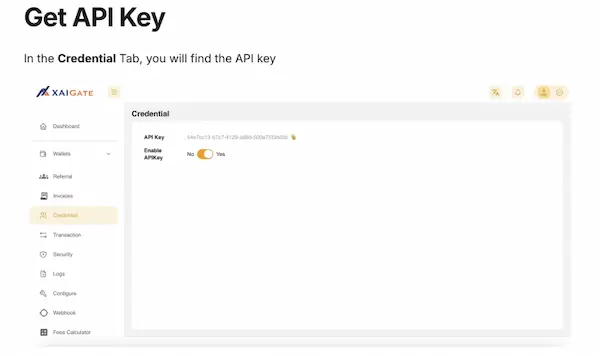
API Integration Best Practices
Create User
{
“name”=”Wilson”,
“owner”: {
“id”: “sha7891bikojbkreuy”,
“name”: “Samuel Passet”,
“species”: “Dog”,}
“breed”: “Golden Retriever”,
}
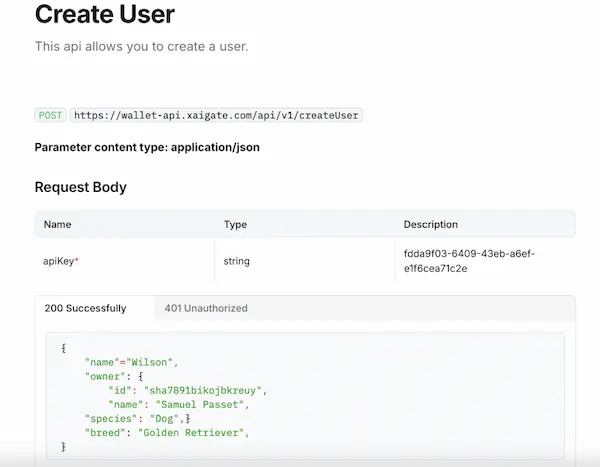
Create New Wallet Address
The generateAddress API is a RESTful API endpoint that allows you to generate a new cryptocurrency wallet address for a specified account.
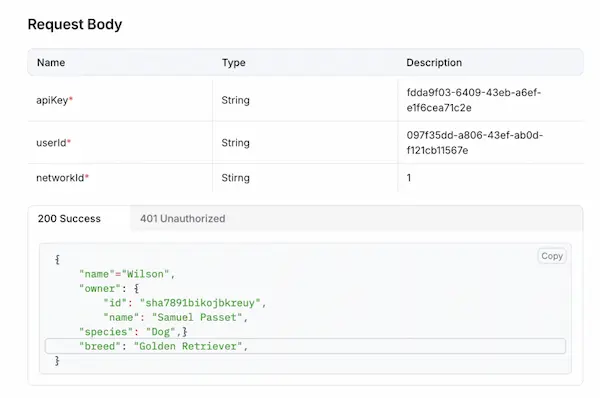
Create Invoice
This API is used to create orders for customers
Parameter content type: application/json
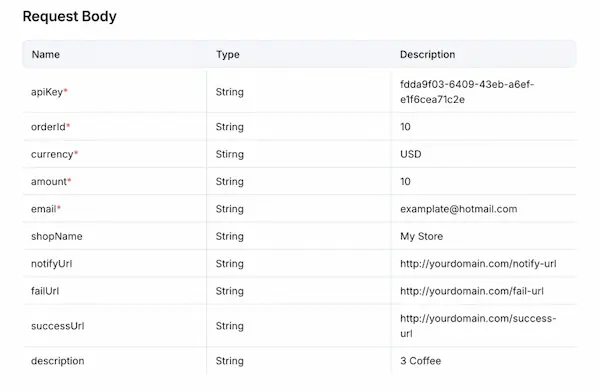
Security Considerations
API Security
When you integrate a crypto payment gateway, security should be your top priority:
- API Key Management
- Store API keys securely using environment variables
- Implement key rotation policies
- Use different keys for development and production
- Request Signing
- Sign all API requests with your secret key
- Implement timestamp validation to prevent replay attacks
- Use HMAC-SHA256 for request signing
- Data Encryption
- Encrypt sensitive data at rest and in transit
- Use strong encryption algorithms (AES-256)
- Implement proper key management practices
Transaction Security
|
Security Feature |
Description |
Implementation |
|
Multi-signature |
Requires multiple approvals for transactions |
Configure wallet settings |
|
Time locks |
Delays transaction execution |
Set appropriate timeouts |
|
Amount limits |
Restricts transaction amounts |
Implement business rules |
Testing Your Integration
Unit Testing
Create comprehensive unit tests for your crypto payment integration:
describe(‘Crypto Payment Gateway Integration’, () => {
it(‘should create payment successfully’, async () => {
const mockOrder = {
id: ‘order-123’,
total: 100.00
};
const payment = await createPayment(mockOrder);
expect(payment.id).toBeDefined();
expect(payment.amount).toBe(100.00);
});
it(‘should handle payment errors gracefully’, async () => {
const invalidOrder = {
id: ‘invalid-order’,
total: -50.00
};
await expect(createPayment(invalidOrder)).rejects.toThrow();
});
});
Integration Testing
Test your webhook endpoints and payment flows:
const testWebhook = async () => {
const testPayload = {
eventType: ‘payment.completed’,
paymentId: ‘pay-123’,
status: ‘completed’,
amount: 100.00,
cryptocurrency: ‘BTC’
};
const response = await fetch(‘/webhook’, {
method: ‘POST’,
headers: {
‘Content-Type’: ‘application/json’,
‘X-Signature’: generateSignature(testPayload)
},
body: JSON.stringify(testPayload)
});
expect(response.status).toBe(200);
};
Common Integration Challenges and Solutions
Challenge 1: Price Volatility
Cryptocurrency prices can fluctuate rapidly, affecting payment amounts. Solution: Implement price locks with expiration times to ensure stable pricing during the payment process.
Challenge 2: Network Congestion
Blockchain networks can experience congestion, causing transaction delays. Solution: Provide clear communication to users about potential delays and implement retry mechanisms.
Challenge 3: User Experience
Crypto payments can be confusing for new users. Solution: Create intuitive UI/UX with clear instructions and QR codes for easy wallet scanning.
Performance Optimization
Caching Strategies
When you integrate a crypto payment gateway, implement caching to improve performance:
const NodeCache = require(‘node-cache’);
const cache = new NodeCache({ stdTTL: 300 }); // 5-minute cache
const getCachedExchangeRate = async (currency) => {
const cacheKey = `exchange_rate_${currency}`;
let rate = cache.get(cacheKey);
if (!rate) {
rate = await gateway.getExchangeRate(currency);
cache.set(cacheKey, rate);
}
return rate;
};
Database Optimization
Optimize your database queries for crypto payment data:
- Index frequently queried fields like transaction IDs and timestamps
- Implement proper pagination for transaction history
- Use database-level caching for improved performance
Monitoring and Analytics
Transaction Monitoring
Implement comprehensive monitoring for your crypto payment integration:
const monitorTransaction = (transactionId) => {
const checkStatus = async () => {
try {
const status = await gateway.getTransactionStatus(transactionId);
console.log(`Transaction ${transactionId} status: ${status}`);
if (status === ‘pending’) {
setTimeout(checkStatus, 30000); // Check again in 30 seconds
}
} catch (error) {
console.error(‘Monitoring error:’, error);
}
};
checkStatus();
};
Performance Metrics
Track key performance indicators:
- Transaction success rate
- Average processing time
- Error frequency by type
- User conversion rates
Conclusion
A crypto payment gateway requires planning, strong security and sufficient testing in order to achieve successful integration. Through this detailed guide, you will be in a very good position to attempt a smooth incorporation of a crypto payment gateway that will offer a smooth user interface and still ensure utmost security level is offered.
The payment of the cryptocurrency remains highly dynamic, and new technologies as well as regulations are surfacing every now and then. Be involved in the industry moves and be ready to change your integration accordingly. It is important to remember that successful integration of crypto payment is not merely associated with the technical part of such implementation, but it is connected to the user-friendly aspect of the effect that can stimulate the adoption and foster trust in you by your customers.
Security, user experience, and scalability are the three symbols to keep in mind as you continue the process of crypto payment integration. Given the proper methodology and such resources, it is possible successfully to incorporate a crypto payment gateway that can thus be useful to the business in the long run.
Frequently Asked Questions
1. How long does it typically take to integrate a crypto payment gateway?
The integration timeline varies depending on complexity, but most developers can complete a basic integration in 2-4 weeks. More complex implementations with custom features may take 6-8 weeks.
2. What are the most important security considerations when integrating crypto payments?
Key security considerations include proper API key management, request signing, webhook verification, and implementing multi-signature wallets for high-value transactions.
3. Can I integrate multiple crypto payment gateways simultaneously?
Yes, many businesses integrate multiple gateways to offer more cryptocurrency options and provide redundancy. However, this increases complexity and maintenance overhead.
4. How do I handle cryptocurrency price volatility during payment processing?
Most gateways offer price locks that freeze the exchange rate for a specific period (usually 10-15 minutes) to protect against volatility during the payment process.
5. What happens if a customer sends the wrong amount of cryptocurrency?
Most gateways have underpayment and overpayment tolerance levels. Small discrepancies are usually accepted, while larger differences may require manual intervention or refunds.
6. Do I need to store cryptocurrency on my servers?
No, reputable crypto payment gateways handle custody and can automatically convert received cryptocurrencies to fiat currency, eliminating the need for you to store crypto assets.
7. How do I handle refunds for crypto payments?
Cryptocurrency transactions are irreversible, so refunds typically involve sending new cryptocurrency to the customer’s address or providing store credit, depending on your refund policy.
8. What compliance requirements should I be aware of?
Key compliance areas include KYC/AML requirements, tax reporting obligations, and data protection regulations. Requirements vary by jurisdiction, so consult with legal experts in your region.
For daily updates, subscribe to XAIGATE’s blog!
We may also be found on GitHub, and X (@mxaigate)! Follow us!
Don’t miss out on the opportunity to elevate your business with XAIGATE’s How to Integrate a Crypto Payment Gateway via API. The three-step process is designed to be user-friendly, making it accessible for all businesses. Embrace this modern payment solution to provide customers with a secure and efficient way to pay. Take the first step towards a competitive edge in the digital realm and unlock the benefits of cryptocurrency payments for online casino today.
Looking to integrate seamless USDT Payment Gateway into your business? XAIGATE provides blockchain-native tools for merchants, developers, and enterprises to accept decentralized payments with confidence. Start Integrate a Crypto Payment Gateway via API today.

